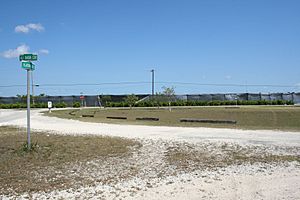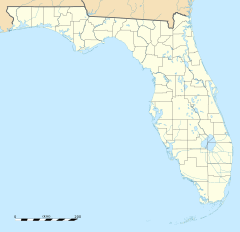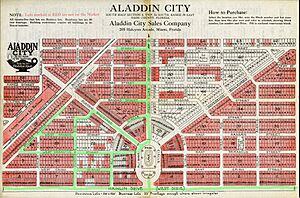Aladdin City, Florida facts for kids
Quick facts for kids
Aladdin City
|
|
|---|---|

Last remaining section of Ali Baba Circle at intersection with Aladdin Boulevard, showing upper northwest quadrant of what was to be Ali Baba Park.
|
|
| Country | United States |
| State | Florida |
| County | Miami-Dade |
| City | Miami |
| Elevation | 10 ft (3 m) |
| Time zone | UTC-5 (Eastern (EST)) |
| • Summer (DST) | UTC-4 (EDT) |
| ZIP codes |
33187
|
| Area codes | 305, 786 |
Aladdin City is a small, undeveloped area in Miami-Dade County, Florida, United States. It's about 20 miles (32 km) southwest of Miami. This place is special because it was meant to be a big, planned city, much like Opa-locka or Coral Gables. However, its development stopped suddenly when the Florida land boom of the 1920s ended.
Contents
The Story of Aladdin City
How Aladdin City Started
In late 1925, a company called The Aladdin Company bought a large piece of land in Florida. This company, from Michigan, was famous for making "kit" homes. These were houses that came in pieces, like a giant LEGO set, and could be put together on site.
The company's founders, Otto and William Sovereign, dreamed of building a city with a "Moorish" style. This means the buildings would look like those from North Africa or Spain, with arches and domes. They planned for 10,000 people to live there.
To get attention, they built a house in just one day! On January 14, 1926, all the building materials were flown in by six planes. A team of 21 workers started at 7:00 a.m. and finished the house by dark. It even had electricity, water, sidewalks, and a garden! News reports said hundreds of people watched this amazing feat. Soon after, an advertisement claimed that 874 building plots were sold on the first day.
The Aladdin Company also planned to open a factory in Aladdin City to make more kit homes. They hoped other factories would move there too. The Seaboard Air Line Railway even planned a train station for the new city.
Problems Begin
Even with good sales, the project faced problems. In October 1925, train companies stopped shipping most goods to Florida, except for food. Then, in January 1926, a ship called the Prinz Valdemar sank in Miami Harbor, blocking access to the sea. These events were early signs that the land boom was ending.
However, the Sovereign brothers stayed hopeful. In February 1926, they announced that shipping problems had delayed them, but things would improve.
On February 22, 1926, Aladdin City officially became the ninth community in the Redland area. On March 14, 1926, they laid the first stone for a new bank building. It was designed in a "Persian" style. Advertisements in March and April 1926 kept promising beautiful homes, businesses, and even a swimming pool. They invited people to see the "beautiful Spanish bungalows already built."
The End of the Dream
The shipping problems finally ended in May 1926. But by then, the land boom was already slowing down. Then, in September 1926, a huge hurricane hit Miami. This caused real estate prices to crash completely.
Some homes, a town hall, and the train station were built, but the city's development stopped. The Aladdin City Handicap horse race was held at Hialeah Park until 1931.
In December 1930, during the Great Depression, the Sovereign brothers held a raffle. They gave away two homes and ten plots of land in Aladdin City to people who bought their kit homes. But by March 1934, they changed the plans and started selling off the land. The Aladdin City Sales Co. officially closed in November 1936.
Only a few of the original Aladdin homes survived over the years. The last one was badly damaged by Hurricane Andrew in 1992. The wooden train station was still standing in 1985 but was likely torn down after Hurricane Andrew too.
Where Aladdin City Was
Aladdin City is located at 25°34′01″N 80°27′14″W / 25.567046°N 80.453846°W, about 10 feet (3.0 m) above sea level.
Original Plan
The city was planned around a large oval street called Ali Baba Circle. Inside this oval was supposed to be Ali Baba Park, with a big swimming pool. A larger oval, Ali Cogia Circle, surrounded Ali Baba Circle. Both circles were meant for shops and businesses.
Two wide streets, Sovereign Boulevard and Aladdin Boulevard, branched out from Ali Baba Circle. Other streets like Damascus Street and Cairo Street also came off the circle. Many streets had names from "Arabian Nights" stories, like Bagdad, Sinbad, and Sahib Streets.
What's Left Today
Today, only a small part of Ali Baba Circle remains, along with Aladdin Boulevard. Parts of Ali Cogia Circle and Damascus and Cairo Streets (now called SW 214th and 215th Streets) are still there. Mustapha Avenue is now SW 164th Avenue.
North of Ali Cogia Circle, Bagdad Street still has its original name. Sinbad, Cathay, and Sahib Streets are now called SW 210th, 209th, and 208th Terraces. They are mostly private roads. Mecca Avenue was renamed SW 163rd Avenue. The eastern half of the planned city has gone back to being farmland, with no signs of the old street layout.




